Employee retention statistics can help us understand what matters to employees, what makes them quit their jobs, and, conversely, how to attract them and convince them to stay.
2022 saw more than 50 million U.S. workers quit their jobs, continuing a trend that started in early 2021.
A quarter of surveyed Joblist users quit a job in 2022, and 35% quit without having another job lined up. Of all the respondents who left a job, only 22% regret their decision. Of those, 49% say finding a new job was harder than they expected, and 13% regret their decision because the economy worsened after they quit.
Much has changed in the world of work since then. With inflation soaring and a potential recession looming, mass layoffs and hiring freezes have become commonplace.
Here we’ll look at what the latest numbers say about employee retention in 2023 and explore the top reasons employees quit, what job seekers want in new jobs, and some tactics and tools (think recognition platforms) you can implement to improve employee retention.
Snapshot: The Current State of the Jobs Market
In this section, we take a look at the state of the labor market in 2023.
Employee Turnover Statistics 2023
In 2022, a record 50.6 million U.S. workers quit their jobs, accounting for 70% of total separations. This is the highest level in the history of the Job Openings and Labor Turnover Survey (JOLTS), which dates back to 2001.
The total annual non-farm U.S. quit rate in 2022 was 3.1%, while the annual total private quit rate was 2.8%.
Based on the currently available data, the ‘Great Resignation’ appears to be continuing full swing in 2023. In addition, young men are leaving the workforce in startling numbers.
So far, the 2023 annual total U.S. quit rate (non-farm) is 2.5%.
While quits are down from the record highs of 2022 in January 2023, dipping below the four million mark for the first time since May 2021, they were back up to above four million in February.
In the heat map table below, which shows U.S. employee turnover levels by month for the past ten years, the months with the highest quit levels are shown in the darkest shades of blue, making it easy to see the ongoing trend.
April 2021 marked the first record-high quit level at 3.9 million quits. Since then, the number of monthly quits has only fallen below 4 million twice—once in May 2021 and recently in January 2023—before returning to the 4-million mark in February. It remains to be seen whether this trend will hold through the rest of 2023.
According to the latest JOLTS data from the Bureau of Labor Statistics, job openings decreased from 10.8 million in January 2023 to 9.9 million in February 2023. Layoffs and discharges decreased from 1.7 million in January to 1.5 million in February.
Quits increased from January’s 3.9 million to 4 million in February (+146,000).
Industries that saw increased quits in February 2023 included:
- Professional and business services (+115,000)
- Accommodation and food services (+93,000)
- Wholesale trade (+31,000)
- Educational services (+18,000)
Meanwhile, quits slowed in the finance and insurance industries (-39,000).
Employee Turnover 2023: What to Expect
According to LinkedIn Learning’s 2023 Workplace Learning Report, 93% of organizations are concerned about employee retention.
Bankrate's jobseeker survey, published in April 2023, found that more people are likely to look for a new job in 2023 than in 2022.
This year, 56% of surveyed U.S. workers said they’re likely to seek a new job compared to 51% in 2022. Additionally, 37% of respondents said are “very likely” to seek a new job—up from 2022’s 32%.
According to Joblist’s 2023 United States Job Market Trends Report, 67% of employed job seekers are planning to quit in 2023. Of these, 34% would take the leap without having a new job lined up.
59% of employees surveyed in Future Forum’s Winter Pulse Survey, published in February 2023, said they’re open to looking for a new job within the next year—a 4% increase since last summer.
Worker Confidence in 2023
While economic uncertainty may make some employees think twice about quitting without having a new job lined up, fear of layoffs may spur other workers to seek alternative employment opportunities.
According to Joblist’s 2023 U.S. Job Market Trends Report, the majority of job seekers feel good about their position in the job market in spite of growing economic concerns:
- 52% of job seekers believe that they have the upper hand in the current job market.
- A third of job seekers described themselves as “very confident” that they could get an equally good or better job.
- Even in tech, 40% of job seekers are “very confident” they could find an equally good job.
- 78% of job seekers believe they can get better pay by changing jobs.
- While employees are concerned about layoffs, overall, only 26% report that they are “worried” or “very worried” about job security, while 47% say they’re “not at all worried.”
- Only 35% of job seekers believe it will be harder to land a new job in 2023 than in 2022.
Similarly, Bankrate’s survey found that, while nearly one in ten employed Americans are “very worried” about their job security, overall fewer people are worried about job security in 2023 than in 2023 — 33% vs. 39% in 2022).
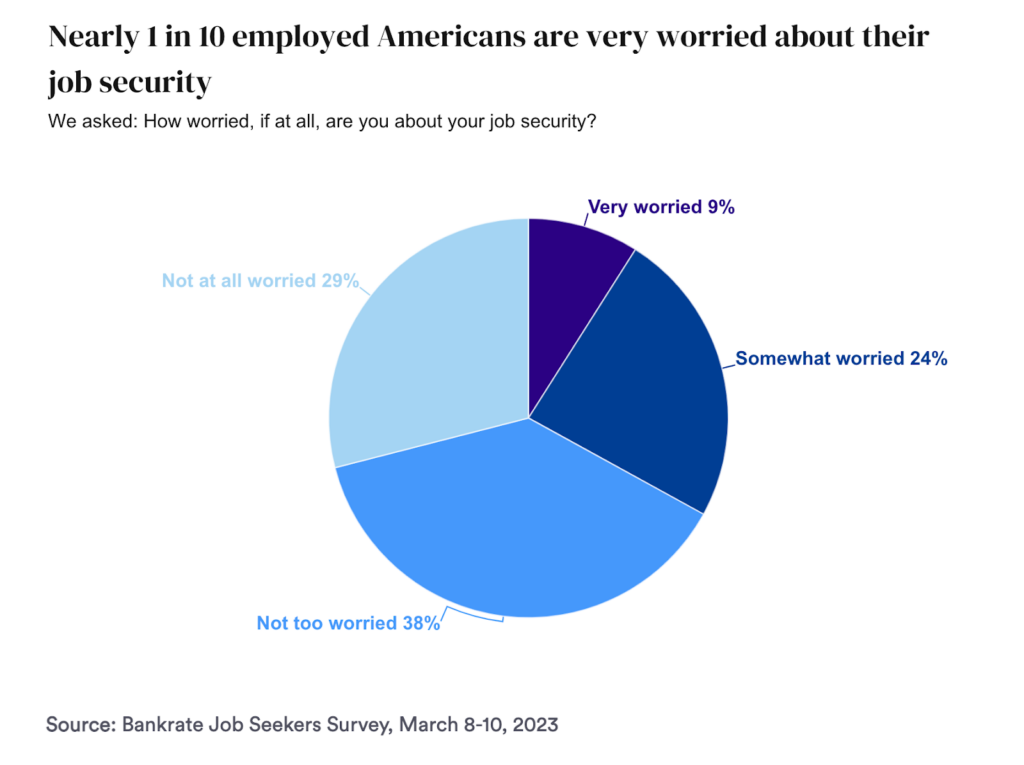
The Labor Market Remains Tight in 2023
The ratio of unemployed people to job openings indicates whether we’re in a slack or tight labor market.
When there are more unemployed individuals than jobs available (a ratio of 1.0 or higher), the labor market is considered to be slack. Conversely, when job openings outnumber the number of unemployed workers (a ratio of less than 1.0), it’s an indication of a tight labor market.
In 2018 and 2019, the ratio ranged from 0.8 to 1.0. In April 2020, the high unemployment levels caused by the pandemic (23.1 million unemployed people to 4.7 million job openings) yielded a high of 4.9.
Since May 2021, the ratio of unemployed workers to available jobs has been 0.9 or lower. Since October 2021, the ratio has held stable at 0.5 to 0.6 every month.
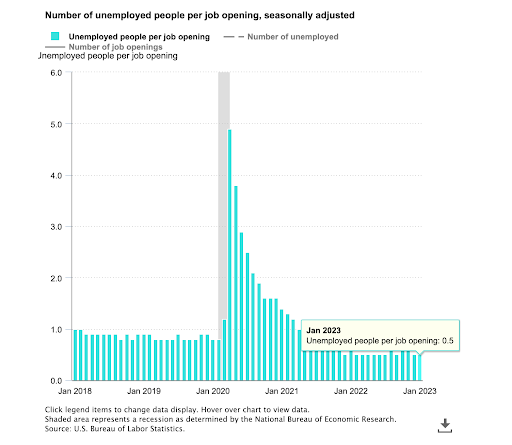
In January 2023, there were 10.8 million job openings to 5.7 million unemployed workers, yielding a 0.5 ratio of unemployed people to job openings—indicating that we are still in the tight labor market associated with the Great Resignation.
Why People Quit: What Drives Employee Turnover or Retention
According to Gallup, some 52% of employees who left an organization voluntarily said that their manager or company could have done something to change their mind about leaving.
This suggests that more than half of quits are preventable if employers can identify the root cause and make changes to address the cause of their employees’ dissatisfaction.
Here are the latest statistics on what’s driving employee turnover (and therefore what organizations should be looking at to improve their employee retention statistics).
Better Pay/Benefits
In 2023, higher pay has become the most important job quality (for 30% of workers), while flexible working hours has dropped to the second place (top for 13% of workers), according to Bankrate’s jobseeker survey.
Similarly, according to Future Forum's Pulse Winter 2022-2023 Snapshot, published in February 2023, the top factor determining job satisfaction for workers is compensation and the second is flexibility.
At 45%, “better pay or benefits” is the most common reason for planning to quit in 2023 given by jobseekers surveyed by Joblist.
Joblist’s research also found that only half of job seekers are satisfied with their current compensation, and only 45% report feeling “financially comfortable.”
And while 53% of employees reported receiving raises in 2022, 89% of these increases were under 10%, and 65% were under 5%. Given 2022’s 7% annual inflation rate, that’s a lot of employees who were disappointed in their raises.
54% of respondents in Bankrate’s survey of U.S. workers said higher pay is more important to them now than before the Covid-19 pandemic.
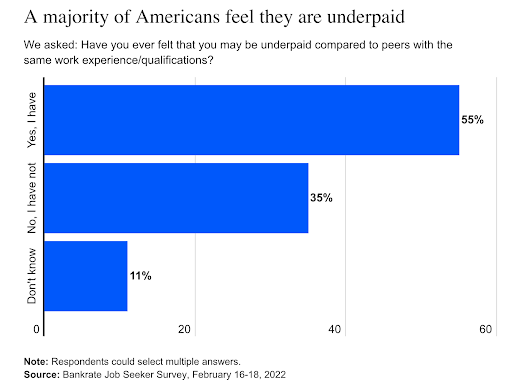
Overall, 55% of workers said they felt underpaid compared to peers with the same qualifications or work experience. By demographic, 60% of Black employees, 56% of white employees, 49% of Hispanic employees said that they felt underpaid.
Check out our article on compensation philosophies to ensure you're aligning pay and benefits with the talent you need.
Flexibility and remote work
A growing list of companies are mandating that employees return to office, but, for those workers who have become accustomed to remote work and/or flexible work schedules, this is a dealbreaker.
According to Joblist, 36% of current job seekers want a fully remote role and 19% want a hybrid position. Employee preferences seem to vary by generation: Nearly half of Millennials want a fully remote role, while 57% of Gen Zers would prefer an in-person job.
Joblist’s study also found that 39% of currently employed job seekers are currently working remotely at least some of the time, and 43% of them say they’d quit if they had to return to the office full-time.
Future Forum’s February 2023 Pulse report found that 67% of workers prefer a hybrid role with the option of accessing a physical office space. The same study found that 75% of employees who are dissatisfied with their current level of flexibility say they plan to seek a new job in the next year.
The good news it it's never been easier to facilitate remote and hybrid working thanks to the proliferation of tools such as hot desk booking software and team communication apps.
Furthermore, while workers’ desire for flexibility is high across the board, Future Forum found that being able to set their own hours (at least to some extent) is more important to employees than where they work. A whopping 93% of employees want schedule flexibility and 81% of desk workers want location flexibility—including 56% of employees who are currently fully office-based.
And when staff do have to go into the office, they want a good reason for it. According to Microsoft’s Work Trend Index report, 78% of business decision-makers and 73% of employees want a better reason to go into the office than simply meeting company expectations.
Microsoft also found that most hybrid employees would go in more often if they knew their direct team members (73%) or work friends (74%) would also be in the office.
While the current economic uncertainty might motivate in-person attendance in the short term, organizations that don’t offer compelling reasons for requiring employees to come into the office may lose talent to companies that do offer remote or hybrid work arrangements.
Related resources:
- Hybrid Working: What Is It And How To Approach It
- Cultivating A Hybrid Workplace Culture For Innovation and Creativity
- Harness The Power Of Asynchronous Working: Best Practices And Tips
Learning Opportunities and Internal Mobility
Back in 2018, LinkedIn’s 2018 Workplace Learning Report found that 93% of employees would remain at a company longer if it invested in their careers.
In LinkedIn’s 2019 Workplace Learning Report, 94% of workers said that their company investing in their learning and development would make them stay longer.
According to LinkedIn’s 2021 Workplace Learning Report, companies with high internal mobility (that is, companies that hire and promote from within the organization—often by upskilling and reskilling employees) retain employees almost twice as long as companies with low internal mobility (5.4 years vs. 2.9 years).
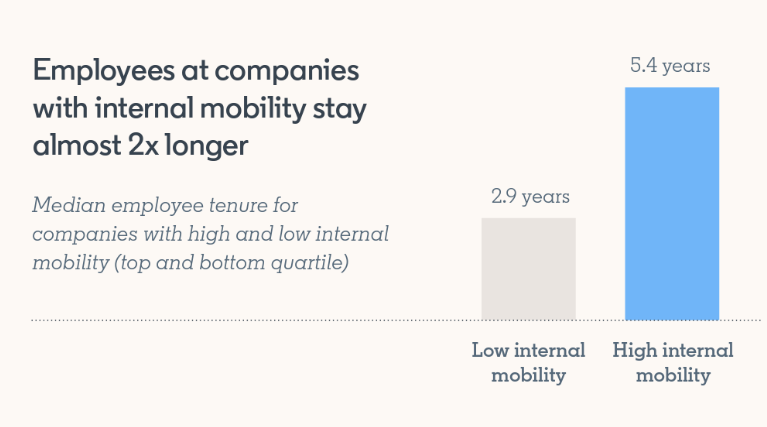
The same study found that employees who changed jobs internally are 3.5 times more likely to be engaged employees than employees who remained in their original roles.
LinkedIn’s 2022 Workplace Learning Report found that employees are 10 times more likely to search for a new job if they feel their current job isn’t putting their skills to good use. So, if you've been holding off on purchasing a learning management system, now's the time! There are plenty out there, and many that cater to specific types of business, like enterprise-level companies or small businesses.
In a similar vein, Microsoft’s Work Trend Index report published in September 2022 corroborates these findings, with 68% of employees saying they would stay with their organization longer if their company offered greater internal mobility.
And that number increases to 75% for people managers and 77% for business decision-makers.
In fact, Microsoft found that the majority of respondents (68% of employees and 77% of business decision-makers) would rather make a lateral move that comes with the opportunity to learn new skills than a vertical move to a more senior position that offers less growth and learning.
The latest LinkedIn Learning Workplace Learning Report further demonstrates the link between internal mobility and employee retention. It found that an employee who has made an internal move within an organization by the two-year tenure mark is 19% more likely to stay with their company (75% vs. 56%).
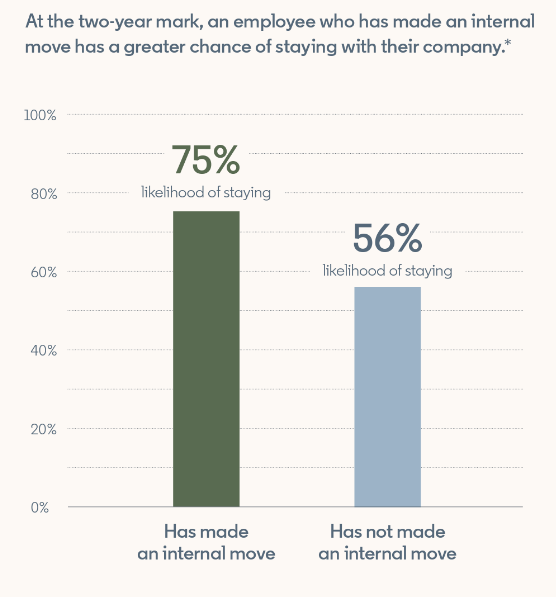
The same study identified the top five factors respondents consider when weighing a new job:
- Compensation and benefits
- Flexibility to work when and where I want
- Challenging and impactful work
- Opportunities for career growth within the company
- Opportunities to learn and develop new skills.
Interestingly, three out of the top five considerations for jobseekers reflect their desire for opportunities to feel challenged, develop new skills, and grow in their careers.
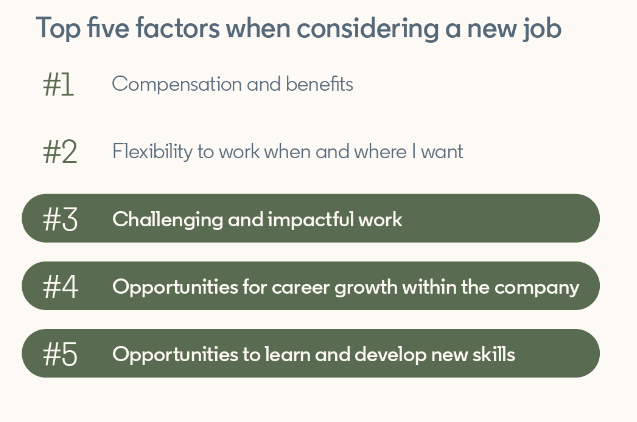
The same report found that employee motivations vary across age groups. Workers aged 18-34 are more likely to prioritize learning, skill building, and career growth, while workers aged 35-49 are more likely to value jobs that enable work-life balance. Meanwhile, workers aged 50+ are more likely to seek work they find challenging and impactful.
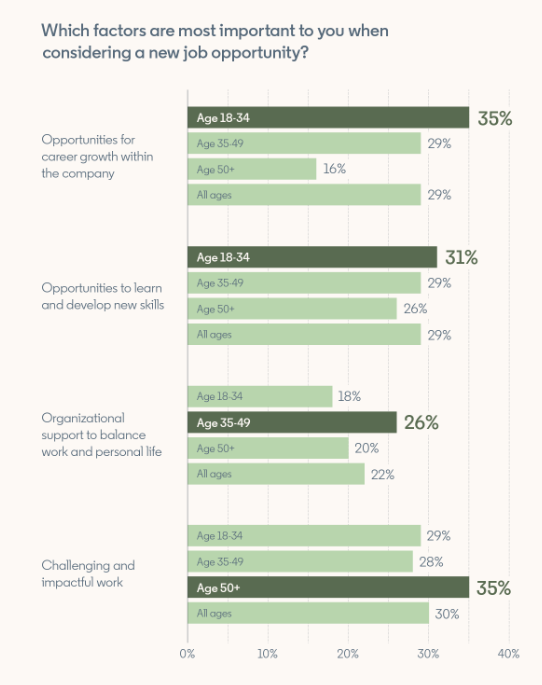
Across all age groups, the desire for challenging and impactful work was the most important factor when considering a new job opportunity.
And while Microsoft’s study found that 76% of employees would stay at a company longer if they could benefit from learning and development support, 56% of employees and 68% of business decision-makers feel their company doesn’t offer enough growth opportunities to make them want to stay long-term.
This sentiment is echoed by Joblist’s 2023 Job Market Report, which found that 73% of workers don’t believe there are significant opportunities for growth at their current company.
In Microsoft’s survey, 64% of Gen Z, 64% Millennials, 60% of Gen X and 41% of Boomers agreed with the following statement: “The best way for me to develop my skills is by changing companies.”
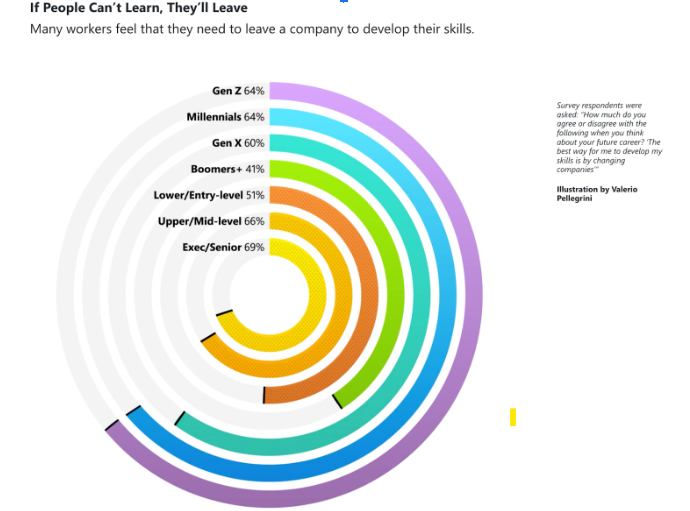
With this data in mind, it’s not surprising that LinkedIn’s latest Workplace Learning Report found that “providing learning opportunities” is the top way organizations are working to improve retention.
The bottom line is that organizations that want to improve their employee retention would be wise to look at what they’re offering in terms of learning and development and internal mobility level.
Some useful resources for this:
- Learning And Development: A (Very) Quick Guide
- How To Create A Learning And Development Strategy In 7 Steps
- Why And How To Build An Internal Talent Marketplace
- Internal Mobility: Why It’s Important And How To Nurture It
- 5 Methods To Help Put Employees In The Driver’s Seat Of Their Career Development
Employee Burnout
Burnout is often given as a reason for high employee attrition rates. Prolonged stress, anxiety, and uncertainty can take a serious toll on employees’ mental health, leaving them fatigued and disengaged at work.
A study by the American Psychological Association conducted back in 2014 found that burned-out employees are 2.6 times more likely to be actively seeking new opportunities and 63% more likely to take a sick day.
Research conducted by McKinsey in 2021 found that “almost half of all employees report being at least somewhat burned out.”
Microsoft’s latest Work Trend Index report found that 53% of managers and 48% of employees say they’re burned out at work.
According to Joblist, half of workers say they’re currently burned out and 62% feel that their employer isn’t doing enough to address burnout.
According to the Future Forum Pulse report published in February 2023, burnout is rising globally, with 42% of survey respondents self-identifying as burned out.
Future Forum also found that burned-out employees are 3.4 times more likely to say they will “definitely” look for a new job in the next 12 months.
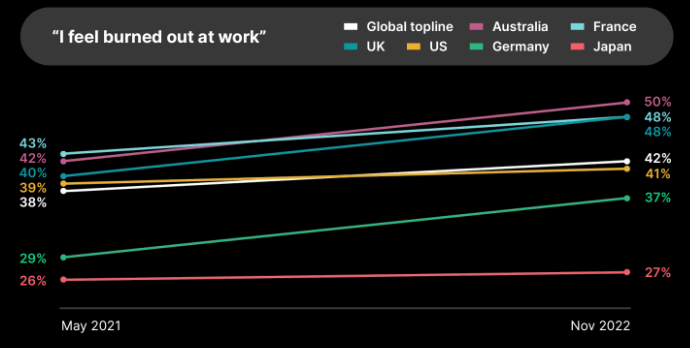
In Joblist’s 2023 United States Job Market Trends Report, job seekers gave the following reasons for feeling burned out at work:
| Cause of Burnout | Percentage Affected |
|---|---|
| Lack of recognition | 46% |
| Limited opportunities for growth | 46% |
| Toxic work environment | 41% |
| Boredom or tired of their job | 29% |
| Working long hours | 26% |
| Unrealistic deadlines or expectations | 21% |
| Stress outside of work | 16% |
| Lack of connection with coworkers | 11% |
Related resource: How To Identify, Pre-empt, And Deal With Workplace Burnout
Low Engagement, Bad Managers and Toxic Workplaces
In Joblist’s 2023 Job Market Report, 39% of respondents who quit a job in 2022 said they left because of bad management or a toxic workplace.
According to Microsoft’s Work Trend Index report, published in September 2022, 81% of workers want their managers to help them prioritize their workload. However, only 31% of employees say that their managers give them clear guidance in one-on-one meetings.
And it’s not just workers that want more clarity: 80% of people managers believe they would perform better with more clarity and guidance on prioritizing their work from senior leadership.
Microsoft also found that employees who believe their company responds to employee feedback are more satisfied (90% vs. 69%) and engaged (89% vs. 73%) than employees who don’t feel their organization uses employee feedback to drive change.
Additionally, workers who believe their company doesn’t respond to employee feedback are more than twice as likely to consider leaving.
This indicates that it’s not enough to measure employee engagement levels through surveys and other feedback mechanisms. Leadership needs to close the feedback loop by making a habit of sharing the feedback they’ve received and how they plan to respond to it—and actually take action
There’s a popular saying that goes “People don’t quit jobs, they quit bad bosses.” While this holds true often enough that there’s a saying about it, it doesn’t tell the whole story.
Sure, some bosses really are terrible people. However, for the most part, bad managers either lack the required training or are a symptom of a company with deeper systemic problems.
To borrow a phrase from the pandemic, crappy management is often comorbid with a toxic workplace culture and disengaged employees.
Consider using employee feedback software to help your organization collect ideas, transform them into actionable next steps, and help your employees feel heard.
Related resources:
- How To Support New Managers With A People Partner Program
- People Management Tips For New And Experienced Managers
- 5 Subtle Signs Your Workplace Culture Is Turning Toxic (And How To Fix It)
- Best Employee Training Software
Health, Wellbeing, and Work-Life Balance
According to Microsoft, 53% of employees (and 55% of parents and 56% of women) say they’re more likely to prioritize their health and wellbeing over work than before, while 47% say they’re more likely to prioritize family and personal life over work than before the pandemic.
Microsoft’s research also found that companies that actively support employee well-being report higher engagement levels, and employees are more likely to say they feel healthy physically and mentally.
More specifically, employees who feel their employer cares about their well-being are three times more likely to be enthusiastic about their job and to recommend their organization as a great place to work.
They’re also three times more likely to report “rarely” thinking about seeking alternative employment opportunities. On the flipside, workers who don’t feel that their employer supports their well-being are twice as likely to report “regularly” considering seeking a new job.
Recognizing workers’ achievements also plays an important role in promoting engagement and well-being and, in turn, retention.
Microsoft found that employees who report getting meaningful recognition on a weekly basis are twice as likely to report high levels of mental and physical well-being than those that don’t. They’re also twice as likely to report feeling capable of managing their work-related stress.
However, Microsoft found that only one in five employees report experiencing a strong sense of mental and physical well-being.
According to Achievers Workforce Institute’s 2022 Engagement and Retention Report, 48% of employees are feeling stressed, and 80% of stressed employees think about looking for a different job “at least sometimes”
In a recent Bankrate Jobseeker Survey, 30% of workers rated work-life balance (remote work, flexible work hours, more paid time off) as their number one priority in a job moving forward. Additionally, 54% of employed parents with children under the age of 18 said they’re likely to request more flexibility in the next 12 months, compared to 40% of child-free workers.
Interestingly, women were more likely than men to name quality of work-life balance as the most important factor (at 35% compared to 26%). This may be because female parents are still more likely to be the primary caregiver.
While achieving work-life balance is something most of us struggle with, it’s even more challenging for working parents who must weigh the costs of childcare against their job responsibilities—even with flexible work policies.
In fact, 46% of parents surveyed in KinderCare’s Modern Parent Index 2023 ranked childcare benefits in their top three employee benefits, and 69% ranked it in their top five. Additionally, 43% of parents would consider switching jobs if they struggled to find affordable child care (and 26% have already done so).
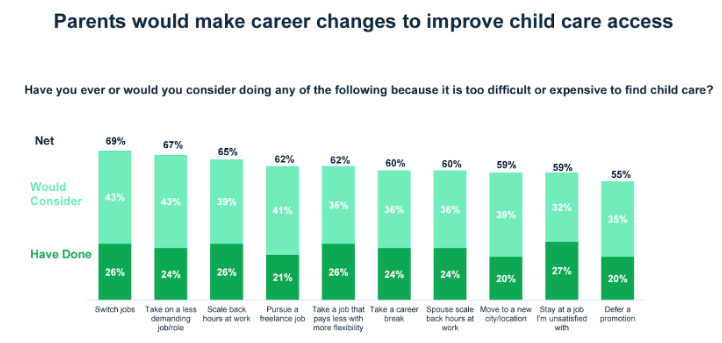
In the same survey, more than half of working parents said they’d stay in their current job if their company offered any of the following child care benefits:
- Pre-tax benefits
- Education funding
- On-demand childcare
- “Off-hours” where parents are unplugged
- Emergency/backup childcare provided by their employer
- Subsidized childcare
- Mixed childcare offerings
- On-site childcare
- Coworking spaces that double as daycares
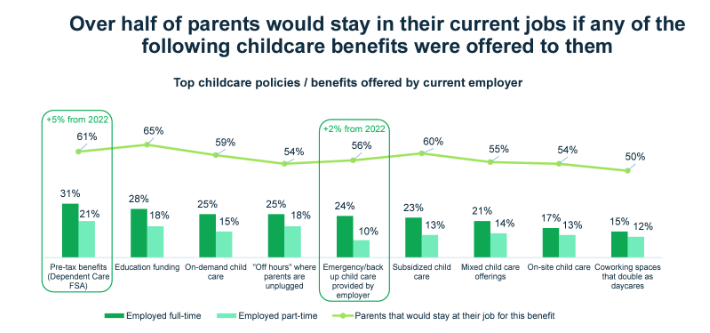
As an employer, it’s worth investing in ways to help your employees improve their well-being and get closer to achieving the ever-elusive work-life balance. In some cases, employees may consider gaining childcare benefits or a four-day work-week a fair trade for losing a measure of flexibility and returning to the office.
Flexible working is one way of providing a better work-life balance and boosting well-ness, as is taking measures to reduce stress and support those with ongoing health issues or particular needs.
Related recourses:
- Reducing Stress In The Workplace: Tips From A Fighter Pilot
- 10 Best Employee Wellness Platforms For Employee Health & Well-Being
- 10 Best Employee Recognition Platforms for Celebrating Top Talent
- 4 Powerful Principles To Help Drive Better Mental Health In The Workplace
- 3 Ways To Support Invisible Disabilities In The Workplace
Focus on hiring and onboarding processes
Fun fact: research has found that roughly 1/3 new hires will leave in the first 90 days.
Most cite a lack of role matching their expectations or misalignment on culture as the primary reasons.
To counter this, we suggest honing your recruitment process by ensuring your job descriptions match the roles and you properly showcase your mission, values and organizational culture. Above all, you also need to ensure complete transparency and honesty throughout the process, something the right applicant tracking system can help you out with.
Another thing to focus on is your onboarding process and any onboarding software you're utilizing.
The common consensus is that having a 30/60/90 day onboarding plan in place will significantly increase the likelihood of a new hire staying, with the added benefit of helping them get productive quicker.
How to Address Employee Turnover Using Data Analysis
Considering the fact that as much as 75% of turnover is for preventable reasons, organizations can make changes that improve retention by addressing the concerns that employees care about and fine-tuning the employee experience.
First, you need to quantify your employee retention and turnover rates (see below).
Next, you can use the above statistic in conjunction with your own employees’ input regarding factors that might be driving attrition, such as low employee satisfaction and engagement levels, to get to the root causes.
By conducting frequent employee surveys (we recommend using employee survey tools for this) as well as stay interviews, exit interviews and 1:1’s, HR leaders, managers, and execs should be able to find patterns and identify employees’ priorities.
From there, they can propose changes that address the specific issues their employees face, whether it’s introducing remote work or flexible hours, revisiting employee benefits packages, working to improve employee engagement, or implementing an employee recognition program that rewards good work.
Setting benchmarks, running experiments, and measuring specific improvements over time will allow organizations to track the success of their engagement and retention programs.
What is Employee Retention Rate?
An organization’s employee retention rate expresses how many of its employees remain with the organization (typically year-on-year) as a percentage.
Calculating Employee Retention Rate
To find your company’s employee retention rate, use the following simple formula:
Divide the number of employees employed at the end of the measurement period by the number of employees at the start of the measurement period and multiply this by 100.
Example:
In 2021, Company X started the year with 12 employees. However, by the end of the year, only 8 of these employees remain.
RR (retention rate) = 8/12 x 100
Thus Company X has a 67% retention rate
Since only individuals who were employed at the start and end of the measured period are included in the retention rate calculation, and retention rate is typically calculated on an annual basis, it’s useful to also calculate the turnover rate—the percentage of employees that quit during that period—to get an accurate view.
What is Employee Turnover Rate?
Employee turnover rate refers to the rate at which employees voluntarily leave an organization within a specified period of time—usually a year.
Calculating Employee Turnover Rate
To find your company’s annual turnover rate, simply divide the number of (voluntary) separations during the measurement period by the average number of individuals employed during the same period (in this case, a year) and multiply this by 100.
Example:
While 4 out of 12 employees left Company X in 2021, it also hired 2 new people. However, before the end of the year, both of these new employees had quit and been replaced again.
TR (turnover rate) = 6/9.8 x 100
Thus Company X has a 61.2% turnover rate
It’s important to note that your retention rate and turnover rate won’t necessarily tell the same story, as demonstrated in the examples above.
This could be for a variety of reasons. For instance, you may find that your tenured employees are more likely to stay put than new hires.
This could in turn stem from various causes ranging from shoddy onboarding to company culture mismatches.
While coming up with theories as to why employees are leaving is a starting point, the more data you can collect, the more accurately you’ll be able to implement positive changes that have a measurable impact on employee retention.
Don’t neglect to follow through on the insights you glean from the data though. No amount of data analysis will improve your attrition rate if you don’t take action to address the reasons employees leave.
Over To You
Avoidable employee attrition very often stems from resentment.
One of the top reasons tenured employees resign is being passed up for a raise and/or finding out that less-experienced or less-qualified junior employees are out-earning them. It’s also one of the main drivers of the overemployment movement’s recent rise to popularity.
Organizations would be wise to calculate the cost of losing experienced talent with institutional knowledge—and then needing to replace them at a much higher cost—against the cost of redirecting some of their talent acquisition budget to talent retention.
Whether it’s being passed over for a well-deserved promotion, discovering your juniors outearn you by a significant amount, feeling burnt out and powerless to change a toxic workplace, floundering under an incompetent manager, feeling like your company doesn’t value you or recognize your contributions, or simply feeling that you’ve exhausted the opportunities for growth your current company offers—turnover is the bitter fruit that grows from small seeds of resentment.
Proactive organizations that frequently take the pulse of employee engagement will have plenty of opportunities to identify these seeds of resentment and nip them in the bud before they grow into high turnover rates.
At this point, it’s commonly shared advice that changing jobs is the best way to advance your career and get that pay bump.
But what if we changed that? What would it look like if we prioritized retaining our best people and invested in helping them develop into the best versions of themselves, instead of fighting tooth and nail over shiny new talent?
Ultimately, people leave when they don’t see a future for themselves in your organization anymore. If you want to keep them, you’ll need to show them that your company offers a better future than your competitors—and that you want them in it.
We hope you found these statistics insightful and that your employee retention initiatives will benefit from this information. Even small improvements like empowering people to self-service using a decent HRMS all add up to creating a better employee experience overall.
If you’re interested in reading more about employee retention, check out How To Attract And Retain Top Talent Through The Employee Life Cycle.
You can also join the conversation over in the People Managing People Community, a supportive community of HR and business leaders passionate about building organizations of the future.


